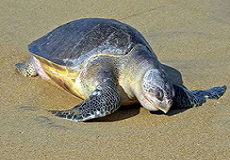

|
1. Alien plants threatening tiger habitats |
Several alien invasive plants growing together can have a detrimental effect to the biodiversities in tiger habitats, a new study has found. About the study:
|
|
2. Olive Ridley Turtle |
The Olive Ridley turtles were seen dead in delta of Godavari In Andhra Pradesh. About: Olive Ridley Turtle occurs in the tropical and hot waters of Pacific and Indian Oceans.
It has been observed that a number of Olive Ridley Sea turtles are nesting around the islands of East Godavari district. Initially the seashores in Odisha were the most sought sites, but now they are arriving at the Hope Island, Sacemento Island, Yellaiahpeta and Surasani Yanam. Major threats:
|




